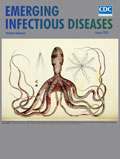
Volume 26, Number 8—August 2020
CME ACTIVITY - Synopsis
Tuberculosis in Internationally Displaced Children Resettling in Harris County, Texas, USA, 2010–20151
Gabriella S. Lamb2 , Andrea T. Cruz, Elizabeth A. Camp, Michelle Javier, Jessica Montour, Tamisha Piper, Umair A. Shah, and Jeffrey R. Starke
, Andrea T. Cruz, Elizabeth A. Camp, Michelle Javier, Jessica Montour, Tamisha Piper, Umair A. Shah, and Jeffrey R. Starke
Abstract
US guidelines have recommended testing children emigrating from high tuberculosis-incidence countries with interferon-gamma release assays (IGRAs) or tuberculin skin tests (TSTs). We describe the Harris County (Texas) Public Health Refugee Health Screening Program’s testing results during 2010–2015 for children <18 years of age: 5,990 were evaluated, and 5,870 (98%) were tested. Overall, 364 (6.2%) children had >1 positive test: 143/1,842 (7.8%) were tested with TST alone, 129/3,730 (3.5%) with IGRA alone, and 92/298 (30.9%) with both TST and IGRA. Region of origin and younger age were associated with positive TST or IGRA results. All children were more likely to have positive results for TST than for IGRA (OR 2.92, 95% CI 2.37–3.59). Discordant test results were common (20%) and most often were TST+/IGRA– (95.0%), likely because of bacillus Calmette-Guérin vaccination. Finding fewer false positives supports the 2018 change in US immigration guidelines that recommends using IGRAs for recently immigrated children.
The World Health Organization (WHO) has estimated that there were 1 million tuberculosis (TB) cases and 234,000 tuberculosis-related deaths among children in 2017 (1). An estimated additional 67 million children were infected with Mycobacterium tuberculosis (2). Testing of children emigrating from high- to low-incidence countries can provide benefit to individual patients and to the community by identifying patients for whom providing treatment would reduce the risk of progression to disease and thus decrease the reservoir for future contagious disease cases.
Not all recently arrived children are at equal risk for TB infection. Refugees, asylees, and victims of human trafficking (VHTs) may be at highest risk as the result of prolonged periods of displacement, undernutrition, poor sanitation, and poor access to medical care (3). In the United States, special immigrant visa (SIV) holders are predominantly children of persons from Afghanistan or Iraq who served as military translators and do not typically live in congregate settings (4,5), potentially placing them at lower risk for TB exposure. Those with parole classification most commonly emigrated from Cuba, a country with a low incidence of TB (6–8).
In 2018, the Centers for Disease Control and Prevention (CDC) updated the preimmigration guidelines for TB testing for immigrants to the United States, recommending that children 2–14 years of age who come from high TB-incidence countries (>20 cases/100,000 population) be tested with an interferon-gamma release assay (IGRA) rather than a tuberculin skin test (TST) (9). Previously, because of resource restrictions, TSTs were performed more commonly in many countries, and 9%–35% of refugee children tested positive (10–15). However, in a large study, almost two thirds of children with positive preimmigration TST results had negative IGRA results on postimmigration testing (11), indicating that many positive TST results likely were caused by prior vaccination with bacillus Calmette-Guérin (BCG).
Almost 10% of refugees, asylees, parolees, or SIV holders in the United States resettle in Texas, and almost 25% of those resettle in Harris County (which includes Houston) (16). Texas is also a human trafficking hub, with many internationally trafficked persons passing through the state (17). We describe the comparative epidemiology of positive TSTs and IGRAs in children of different immigration classifications cared for through the Harris County Public Health Refugee Health Screening Program.






















.png)











No hay comentarios:
Publicar un comentario